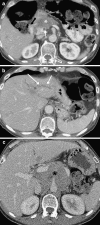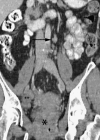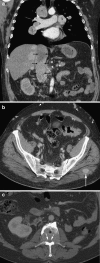Common primary tumours of the abdomen and pelvis and their patterns of tumour spread as seen on multi-detector computed tomography
- PMID: 22347948
- PMCID: PMC3259344
- DOI: 10.1007/s13244-011-0089-0
Common primary tumours of the abdomen and pelvis and their patterns of tumour spread as seen on multi-detector computed tomography
Abstract
BACKGROUND: Multidetector computed tomography (MDCT) has become the main investigation of choice for staging of many cancers. AIM: The purpose of this pictorial review is to discuss the imaging appearances on CT of some of the more common cancers arising within the abdomen and pelvis and to describe their typical sites of local, nodal and haematogenous tumour spread. METHODS: Cancers arising from the stomach, pancreas, colon, kidney, ovary and prostate will be reviewed. RESULTS: Awareness of the characteristic sites of tumour spread is important to allow accurate identification of all sites of disease. CONCLUSION: This will clearly have an impact on both patient management and prognosis.
Figures









References
-
- Rossi M, Broglia L, Graziano P, Maccioni F, Bezzi M, Masciangelo R, Rossi P. Local invasion of gastric cancer: CT findings and pathologic correlation using 5-mm incremental scanning, hypotonia, and water filling. AJR Am J Roentgenol. 1999;172(2):383–388. - PubMed
-
- Chourmouzi D, Sinakos E, Papalavrentios L, Akriviadis E, Drevelegas A. Gastrointestinal stromal tumors: a pictorial review. J Gastrointestin Liver Dis. 2009;18(3):379–383. - PubMed
LinkOut - more resources
Full Text Sources
